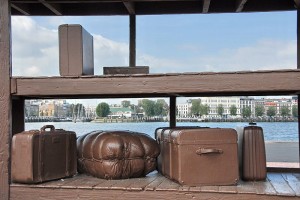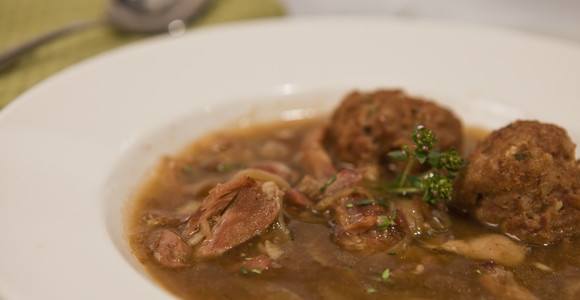Luggage follies: where’s my moose meat?
Don’t you just hate it when the airline loses your suitcase full of …frozen moose meat?

This Rotterdam sculpture, ‘Lost Luggage Depot’, was made by the Canadian plastic artist Jeff Wall (1946-). It is made of cast iron and symbolizes the goodbye of the many emigrants to their former lives. Image: Rotterdam ‘Kop van Zuid’, Creative Commons
That was the story for Liam English, whose suitcase on an Air Canada flight only completed part of his journey. As recounted for the CBC:
What was inside the suitcase? Eleven kilograms of frozen moose meat, including four moose roasts, four steaks, three packs of ground moose and four packs of moose sausages.
English, originally from Newfoundland but now living in Ottawa, says he decided to stock up while visiting his family.
“It’s like gold to anyone in Newfoundland,” he tells As It Happens host Carol Off. “It’s one of the best things you can eat.”
This story broke when the meat went missing and the hunt was on. Early theories included the possibility that security screening may have diverted that suitcase. Or a fellow Newfoundlander may have tripped to the contents and been unable to resist that temptation.
The lost bag was eventually found in Toronto. But that took 4 days, by which time the meat had thawed into an unhappy state, ruining everything inside, as detailed in follow-up coverage:
“I opened it up and sure enough, the moose meat was spoiled in my bag,” English told CBC News Thursday.
“The smell was probably the most putrid thing I’ve ever put to my nose.”
“Me and the Air Canada rep were gagging — it was pretty bad,” he said.
If English had made it back with his haul intact, he could have found moose recipes at this “All about Moose” website.
(I think I’ll stick to bags of raw macadamia nuts for my “taste of home” re-supply. Much safer.)
If only moose will do, here’s a heritage recipe from Parks Canada for Marm Bailey’s Moose Muffle Soup:
This 200-year old recipe is attributed to Marm Bailey, who served the soup in Annapolis Royal in the 1800s. Marm Bailey’s husband, Thomas Bailey, was an officer posted at Fort Anne. After his death, she opened a boarding house and dining establishment on Lower Saint George Street. It was there that she started serving her world-famous Moose Muffle Soup. Folks came from miles around to have a bowl, and Marm Bailey even bottled the soup and exported it to England.
The original recipe (below) appears in “The Romance of Old Annapolis Royal,” written by Charlotte Isabella Perkins and published by the Historical Association of Annapolis Royal in 1934. It has been adapted by Alan Melanson, a Parks Canada interpreter at Fort Anne National Historic Site.
1 moose nose
1 knuckle of veal
12 meatballs (use your own meatball recipe to put your signature on the recipe)
2 – 3 onions, chopped
Yolks of 12 hard boiled eggs
2-3 tbsp catsup
Marjoram, cloves, cayenne, thyme, and salt (to taste, depending on size of moose nose)
1 bottle of port
Remove all hair off the moose nose, using pliers to remove larger bristles. Thoroughly rinse and clean the moose nose, and place moose nose in a large cauldron (size of cauldron depends on size of moose nose). Add water to cauldron so that it rises 3 inches above the moose nose. Bring the water to a boil and let it boil vigorously for 45 minutes. Reduce to a simmer for the morning and most of the afternoon. In this manner all the juices, flavours and gelatinous substances will combine to make a wonderful broth.
Remove moose nose from cauldron and pull the meat off the nose. Chop the moose nose meat into small pieces and place the meat in the broth. Add all remaining ingredients to the cauldron and simmer on a low heat for about 3 hours.
Ladle into large soup bowls and serve with thick homemade bread and a glass of red wine.
Tags: canada, Liam English, moose, travel









love the moose meat story…sounds like the sticky thieves in Quebec that made off witha large quanty of maple suryp a bit ago….rcmp on the trail…..a sticky wicket to say the least…but in this case all they have to do is have a good sense of smelll…..like in the land of PM HARPO, oly there is a far bigger smell….than moose meat!
Alaska Air lost a suitcase full of moose and salmon one Christmas we flew home to NY to visit. It was delivered four days later, still frozen and ready to go. I was fearing the worst but we had declared it as frozen goods and wherever it ended up travelling, it was properly cared for.
I used to fly back and fort hto Alaska for work. One day i was waiting to go through the x ray, and i put my hand on the side of it, only to find it covered in slim. I recoiled, raised my hand to find the slim dripping from it. The TSA agent informed me that someone had just come though with a salmon. I looked up to see the guy, walked down the terminal with the fish, holding it by the gills like he had just caught it…. (best part was that it was a salmon that had already spawned… it was basically dead when he caught it…)